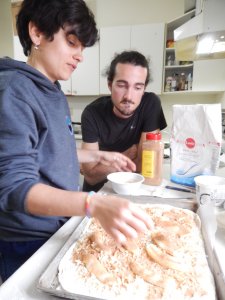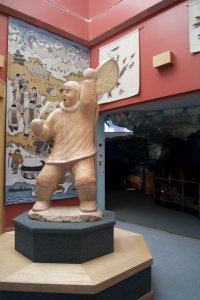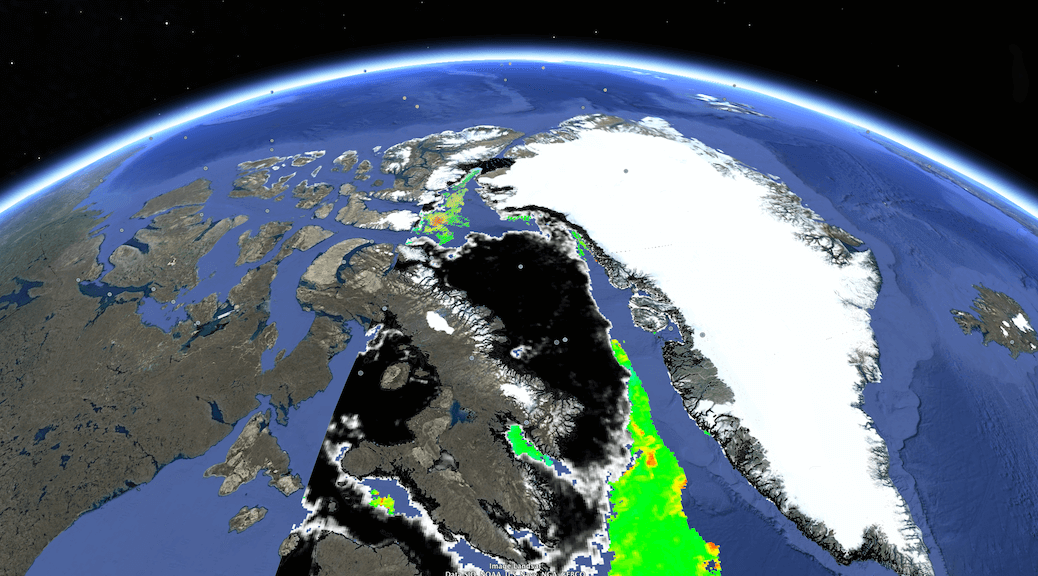Tag Archives: Ice camp
Cuisiner au dessus du cercle polaire

Quand on m’a demandé de venir cuisiner pour Greenedge à Qikiqtarjuaq, honnêtement je ne savais pas a quoi m’attendre. J’ai déjà été chef dans un restaurant et traiteur, mais cuisiner pour des chercheurs dans le grand nord canadien où l’approvisionnement est limité à 3 cargos pour les 3 mois du projet et où tout est hors de prix dans les deux petites épiceries de la communauté, a été tout un défi. Planifier des repas pour 20 à 35 personnes, trois fois par jour dans une cuisine de maison ça peut s’avérer compliqué. Une journée typique (quoique chaque jour était tout aussi surprenant que le précédent!) était :
 – Levé à 6h du matin : Préparation des petits thermos du nourriture pour les gens allant sur le camp de glace soit de 12 à 20 personnes. Soupe, plat chaud, œufs, fromage, biscuit et pain maison, noix et fruits séchés ainsi que thé et café.
– Levé à 6h du matin : Préparation des petits thermos du nourriture pour les gens allant sur le camp de glace soit de 12 à 20 personnes. Soupe, plat chaud, œufs, fromage, biscuit et pain maison, noix et fruits séchés ainsi que thé et café.
– 7h30: début du déjeuner pour le groupe de scientifiques, œuf, bacon, pain, céréales, yogourt et fruits, le tout jusqu’à 9h. Pendant ce temps, je commençais une double recette de pain et cuisinais biscuits pour le camp et un gros dessert pour le soir.
– Après 9h la préparation du dîner pour les gens qui était en ville, cuisson du pain et de la soupe pour le soir.
– 12h30 à 13h30: dîner. Ensuite si j’étais chanceux j’avais un petit deux heures de libre dans l’après-midi.
– Vers 16h00 commençait la préparation du souper: plat mijoté, rôti, poisson ou la fin de semaine; soirée barbecue ou soirée pizza.
– 19h00: l’équipe revient du camp, alors pour moi nettoyage de tous les thermos et des glacières.
– 19h30 – 20h30: souper.
– 21h00: vaisselle.
– 22h00: préparation du lunch pour le lendemain.
– 23h00: Fin de la journée et le tout qui recommence le lendemain!

L’autre réalité de cuisiner dans l’Arctique par rapport au sud c’est que dans le sud on passe une commande de frais et de viande à la fin de chaque journée pour le lendemain. Ici, on a que trois commandes pour l’été, c’est à dire une par mois, alors le frais est rare. Patate, oignon, choux, courge et carotte peuvent durer sans problèmes tout le mois hors du frigo, mais les fruits sont beaucoup plus rares. Quand il y en a, on en profite et on est content et sinon on s’en passe! L’autre variable non négligeable c’est qu’on est complètement dépendant de la météo. À mon arrivée, j’ai fait une commande supplémentaire pour le passage de scientifiques débarquant de l’Amundsen ce qui m’ajoutait 15 personnes aux 20 déjà présentes. J’étais supposé la recevoir juste à temps (puisque qu’il y a un délai de 10 jours entre le moment où on passe la commande et où on est supposé la recevoir). Par contre, dû au mauvais temps, elle est arrivé 10 jours plus tard et si rien n’arrive, rien ne part! Alors avec le brouillard, les gens qui devait partir sont restés bloqués ici et en même temps je ne recevais rien pour les nourrir. Tout ça pour dire qu’il faut avoir de l’imagination et un peu de débrouillardise pour venir cuisiner dans le nord!

Finalement, tous les chercheurs qui viennent ici font du terrain presque chaque jour, alors passer 10h dehors ça creuse l’appétit. Quand je mentionne que je nourrissais 35 personnes au plus gros de l’été, je cuisinais plutôt pour 55. Je peux vous dire que quand tu reviens d’une journée sur la banquise le repas du soir est très important. C’est ce qui remonte le moral si la journée a été mauvaise, c’est ce qui réchauffe et c’est aussi ce qui rappelle la maison quand les temps sont plus durs. Bref, c’est très important.
L’expérience a été exceptionnelle sur plusieurs points. Être en contact avec une nouvelle culture et pouvoir cuisiner de tous nouveaux produits comme: l’omble de l’arctique, du phoque et du narval. Parler et côtoyer les Inuits et en apprendre un peu sur leur monde et leur culture. Voir ces paysage, ces montagnes, cette nature d’une beauté sans égal. Vivre avec des gens inspirants des quatres coins de la planète. Ça a été toute une chance de venir ici et j’espère que l’expérience se répétera à nouveau.
Yanick Asselin
NDLR :
Dejeuner (Qc) = Petit-dejeuner (Fr)
Diner ou lunch (Qc) = Dejeuner (Fr)
Souper (Qc) = Diner (Fr)
All roads lead to the ice-camp, even the ‘Road to Nowhere’

I left Québec the 18th of June-Saturday in the beginning of afternoon for a long trip to Qikiqtarjuaq (see previous post ‘The time you enjoy wasting is not wasted time’) in order to board on the Amundsen icebreaker the 23rd. I was happy and enthusiastic to leave my everyday habits for this crazy adventure… but quickly, and although I was supposed to reach Qikiqtarjuaq several days in advance of the Amundsen, I realized I would have to completely change my plans.

The first part of the trip from Québec to Ottawa was nice and easy-going, everything became (too) complicated when I reached Iqaluit, the capital of Nunavut, one the main entrances to the Canadian Arctic. After a Sunday morning flight Ottawa-Iqaluit, I was booked on the afternoon flight to Qikiqtarjuaq. After waiting several hours, the flight was cancelled due to the bad weather forecast, rather usual, basically you have 50% chance of a scheduled flight departing. No big deal, I was rebooked on the next day’s (Monday) morning flight, and actually I was not the only one at the mercy of the bad weather: nine GreenEdge participants were trapped with me in Iqaluit.

We went back to the airport early the next morning. We checked-in and boarded the plane. We were all so happy to leave Iqaluit and moreover, at the prospect of reaching our final destination soon. Several hours later, the smiles disappeared from our faces: about one hour after we landed in Pangnirtung (the mandatory stop before Qikiqtarjuaq) and with two hours of total delay, the plane took off again… but for Iqaluit… back to our starting point. Seven of us had the chance to be rebooked on the Tuesday afternoon flight and three of us (including me) on the Wednesday morning flight. The Tuesday flight thus took off, leaving us behind, abandoned at the door to Canadian Arctic. The positive side of the story was that we had all time in the world to discover the (few) attractive sites of Iqaluit starting with museums, visitor center, handcraft galleries, and ending in bars and restaurants. We even profited from the aboriginal day events (June 21st) and especially enjoyed the local music concerts, a beautiful experience. But after several days touring around in this small and isolated community of 6700 people, we inevitably ended wandering on the ‘Road to Nowhere’, East of Iqaluit: this, I thought, was the sad end of my adventure.

Indeed, Wednesday morning and, unfortunately for us, the next couple of days, we followed the same routine: packing our luggage, reaching the airport at 6 AM, checking-in, waiting, learning that the flight was cancelled, rebooking on the next flight, yet we always had the same hope that the plane would at least take off. The problem was that the day we were due to board the Amundsen was getting closer and closer, and when Thursday arrived, we had been on stand-by in Iqaluit for 5 days already. Hopefully, the head of the scientific mission on the Amundsen would decide to wait for us for one day. The Friday flight was thus our last hope to reach Qikiqtarjuaq in time to board the Amundsen… but (of course!) the flight was, again, cancelled and the Amundsen finally had to leave without us. What a nightmare! For my two companions in misery the adventure was over and they immediately took a flight back to Ottawa (and from there to Québec and Paris) to go home. I was supposed to replace Pierre-Luc on the Amundsen so that he could work at the ice-camp until the end of the mission. However, he finally had to stay on the Amundsen, and I was redirected to take over his ice-camp duties. All right, why not, let’s replace an exciting time on the Amundsen by an even more exciting time on the ice-camp… although I had no idea when I would finally reach Qikiqtarjuaq!

Unexpectedly, the weather turned much better on Saturday (June 25) and I was FINALLY able to take a flight and land in the magnificent Inuit community imprisoned between the bay and mountains… after seven days being stuck in Iqaluit: a new record for GreenEdge participants (the former one was five days, a joke) I could now easily be a tourist guide in Iqaluit as I have explored every square meter of the city.
The conclusion of this story: The Arctic is not a ‘gift’ easily attained, it is necessary to show a high level of flexibility and adaptability to even reach it… but this is still far below the level required by Arctic ecosystems and populations that face ongoing climate change.



